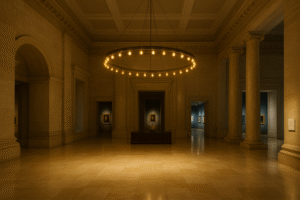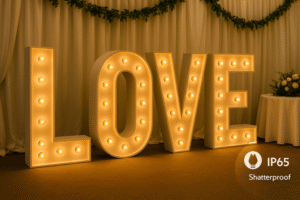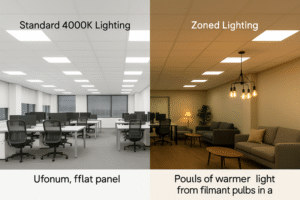You see those generic LED bulbs in a box and think "utility." The idea of creating something unique and beautiful for your home seems to require specialist skills and expensive, custom parts.
Yes, that standard LED filament or G9 capsule bulb is the perfect starting point for your next DIY project. With basic supplies and a little creativity, you can craft custom lamps, art pieces, and garden features that look stunning.
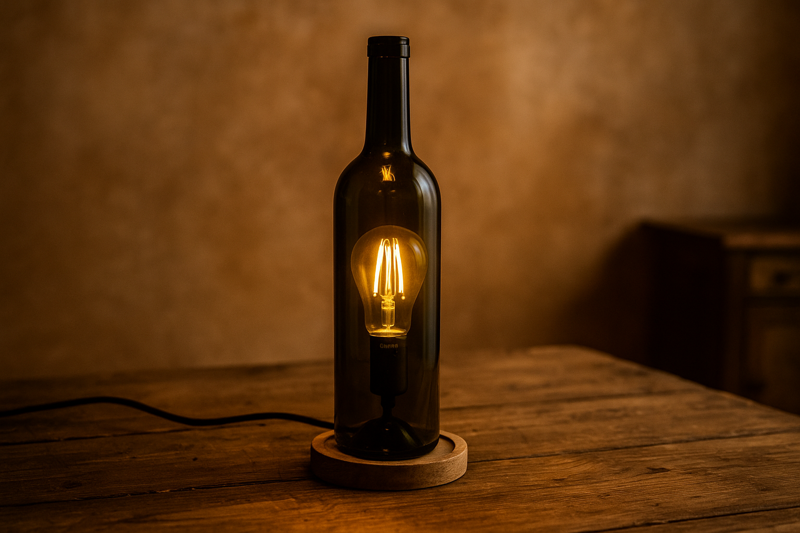
I once visited a small art fair where a local artist was selling these incredible, handcrafted light fixtures. One piece, a sort of starburst chandelier made from copper pipes, caught my eye. I looked closer and saw he was using dozens of our tiny G4 LED bulbs. I struck up a conversation with him. He told me, "I used to struggle with custom lighting. It was hot, unreliable, and expensive. Then I realized your standard, high-quality G4 bulbs are like perfect little building blocks. They are reliable, they don't get hot, and the light is consistent. It freed me to focus on the art." That conversation stuck with me. We make components, but our customers are the true artists who bring them to life in ways we could never imagine.
How Can You Start a DIY Lighting Project Safely?
You're excited by a project idea, but the thought of working with electricity is intimidating. The fear of getting a shock or creating a fire hazard stops you before you even begin.
Always work with the power completely disconnected. For most DIY projects, start with low-voltage (12V) systems, which are inherently much safer. Ensure all components are properly rated for the electrical load.
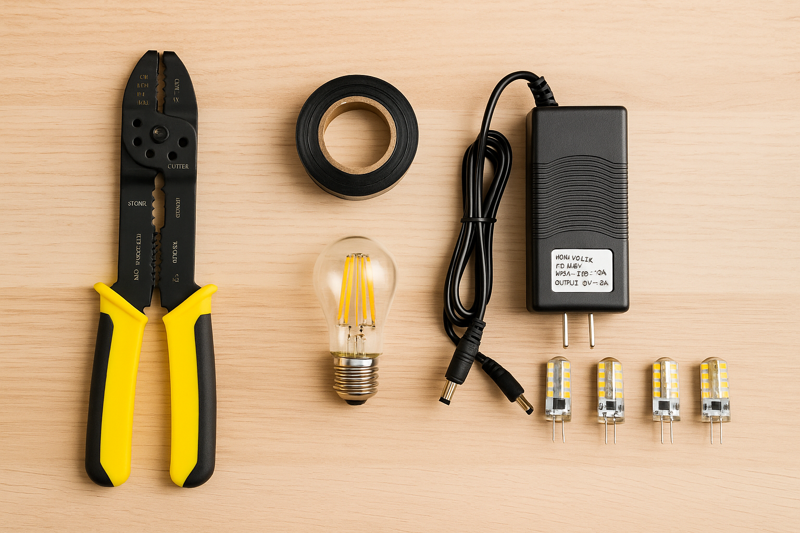
Before we get into the fun stuff, this is the most important part. As a manufacturer, safety and reliability are at the core of everything we do, and that same mindset should apply to any project you build. You don't need to be a certified electrician to create amazing things, but you do need to respect the fundamentals of electricity. The single best piece of advice for beginners is to work with low-voltage Direct Current (DC), usually 12 volts. This is the same type of power your car or many small electronics run on. It's far less dangerous than the high-voltage Alternating Current (AC) in your walls. You can buy a simple 12V power adapter that plugs into the wall, which safely converts the high-voltage AC into low-voltage DC for your project. This one step opens up a world of creative possibilities without the risks associated with mains wiring. It’s the perfect way to build your confidence and skills.
Essential DIY Lighting Safety Rules
| Rule | Why It's Important | How to Do It |
|---|---|---|
| Work Unplugged | The rule. Prevents any risk of electric shock while you're building. | Always unplug the power supply from the wall outlet before you touch any wires or components. No exceptions. |
| Use Low-Voltage (12V)1 | Significantly reduces the risk of dangerous electric shock. | Use a 12V power adapter for your projects. Many LED products, like G4 bulbs and strips, are designed for 12V. |
| Don't Overload Your Power Supply | Prevents overheating and potential fire hazards. | Add up the wattage of all your bulbs. Make sure the total is less than the wattage rating of your power supply (e.g., ten 2W bulbs = 20W, so use a 30W power supply). |
| Insulate All Connections2 | Prevents short circuits which can damage components or cause a fire. | Cover every wire connection completely with electrical tape or, for a more professional job, use heat-shrink tubing. |
Can You Make a Designer Lamp from an Old Bottle?
You love the look of custom table lamps in high-end decor stores but can't justify the price tag. You have beautiful glass bottles at home that seem like they could be used for something.
Yes, absolutely. With a simple "bottle lamp kit" from a craft store and a beautiful LED filament bulb, you can turn almost any empty wine, spirit, or decorative bottle into a stunning, custom lamp in under an hour.
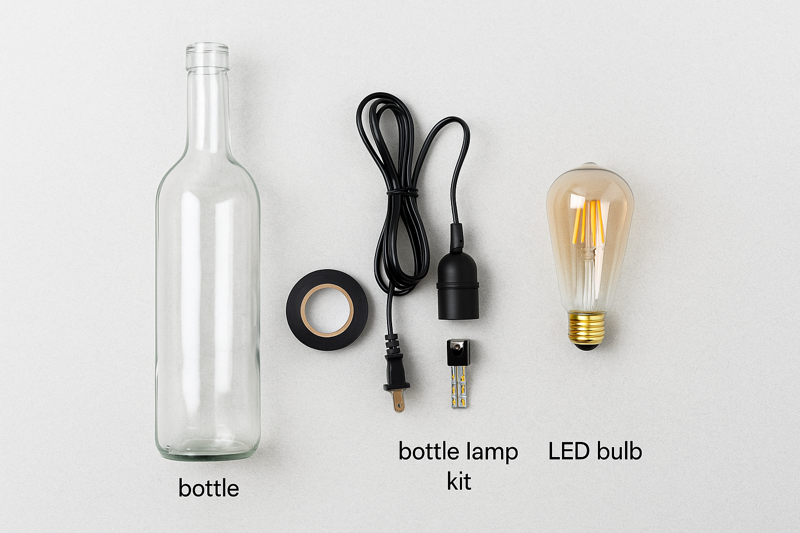
This is the perfect first project. It's incredibly simple, requires no drilling or complex wiring, and the final result looks fantastic. The secret to making it look like a high-end designer piece isn't in the wiring—it's in the bulb you choose. The light source is the star of the show. This is where our LED filament bulbs, like the classic ST64 "Edison" style, truly shine. The intricate filament design is a piece of art in itself, and the warm 2200K color temperature we produce casts a beautiful, nostalgic glow that makes any room feel cozier. The process is simple: you find a bottle you love, buy a lamp kit that includes a pre-wired socket and cord, and choose a statement bulb. A client of mine who owns a chain of bars in the Netherlands started making these for all his tables using old gin bottles. He told me customers constantly ask where they can buy the lamps. It's a testament to how a simple, high-quality component can elevate a DIY project into something truly special.
Your 4-Step Bottle Lamp Guide
- Gather Your Materials: You'll need an empty, clean glass bottle, a "bottle lamp wiring kit3" (readily available online or in craft stores), and a standout LED bulb. I highly recommend an hongyu vintage-style filament bulb4.
- Assemble the Stopper: The kit will come with a rubber stopper that has a hole through the center for the wire. Feed the lamp cord through the stopper until the socket sits securely on top.
- Insert and Secure: Simply push the rubber stopper firmly into the mouth of the bottle. Most stoppers are tapered to fit a variety of bottle openings.
- Add the Bulb and Enjoy: Screw in your beautiful LED filament bulb, plug it in, and you're done. You've just created a custom piece of decor.
How Do You Build a Breathtaking 'Light Sculpture'?
You've mastered simple lamps and now you want to create a larger, more artistic centerpiece. You envision something like a cloud lantern or a starburst chandelier, but you're unsure how to work with multiple bulbs.
You can create complex light sculptures by wiring multiple low-voltage bulbs in parallel to a single power source. Using small, low-heat bulbs like G4 or G9 LEDs allows you to embed many points of light into different materials.
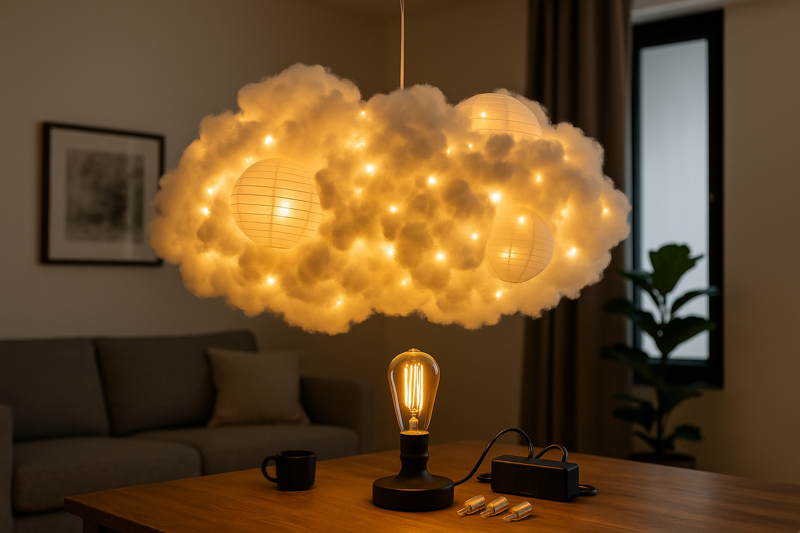
This is where you graduate to becoming a true lighting artist. The key here is using small, efficient, and cool-running bulbs. Old halogen G4 bulbs would be a fire hazard in a project like a cotton cloud lantern, but our LED G4 bulbs produce almost no heat, making them perfectly safe to embed in a variety of materials. The concept you need to understand is "parallel wiring." It sounds technical, but it's simple: it just means every bulb gets its own direct connection to the positive and negative wires from your 12V power supply. You can do this by using two main "bus" wires and then branching off a connection for each individual bulb. For a cloud lantern, you would hide this wiring inside paper lanterns, then wrap the structure in cotton batting. When you turn it on, the many small points of light diffuse through the cotton, creating an ethereal, cloud-like glow. For a starburst or "Sputnik" chandelier, you can run the wires through copper or brass tubing for a modern, industrial look. The creative possibilities are endless once you realize you can safely place many small points of light wherever you want.
Parallel Wiring5: The Key to Multi-Bulb Projects
This method ensures that every bulb receives the same voltage and shines at the same brightness.
- Establish Your Main Wires: Run a positive (+) wire and a negative (-) wire from your 12V power supply6. These are your main "bus" wires.
- Connect Each Bulb: For each bulb, connect one of its leads to the positive bus wire and the other lead to the negative bus wire.
- Repeat: Continue connecting all your bulbs in this way.
- Insulate: Make sure every single connection is fully insulated with electrical tape or connectors.
Can You Bring Your Garden to Life After Sunset?
Your garden or patio is beautiful during the day, but at night it disappears into a dark, uninviting space. You want to add magical, ambient lighting without a complex, expensive landscaping installation.
Yes. By using weatherproof sockets and low-voltage wiring, you can create enchanting outdoor lighting features. Simple projects like mason jar "fireflies" or illuminated planters can transform your garden into a magical nighttime retreat.
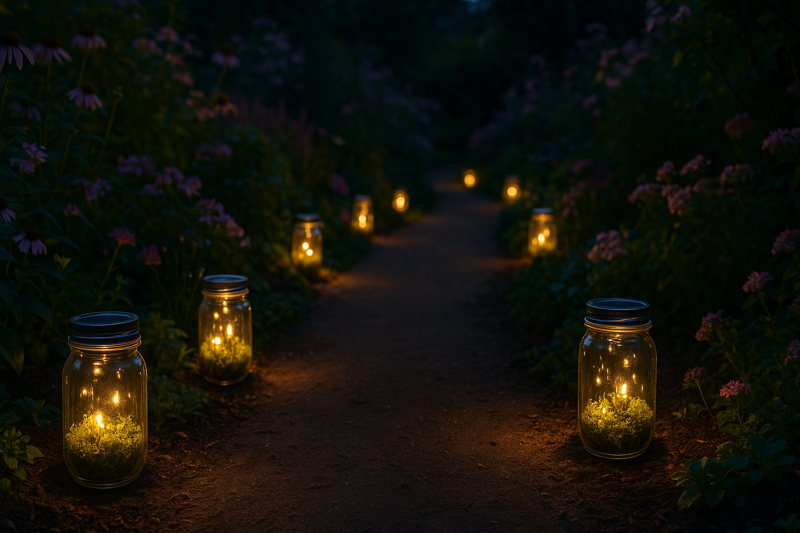
Outdoor lighting is all about creating mood and highlighting features. You don't need blinding floodlights; you need gentle pools of light that create atmosphere. This is another area where low-voltage (12V) DC is your best friend, as it's far safer for outdoor and potentially damp environments. One of my favorite and simplest projects is creating "firefly" jars. You take a simple mason jar, place a bit of moss or decorative stone at the bottom, and suspend a single 12V G4 bulb inside. Then, you run the discreet, low-voltage wire out from under the lid and connect it to a longer wire that goes back to a weatherproof power supply. You can make a dozen of these and scatter them through your flowerbeds or hang them from tree branches. The effect is absolutely magical. You can also apply this principle to illuminate planters or walkways. The key is to use components designed for the outdoors—look for weatherproof lamp holders and burial-grade low-voltage cable to ensure your creation is both beautiful and durable.
Conclusion
Standard LED bulbs are not just utilities; they are creative building blocks. With a focus on safety and a bit of imagination, you can transform them into unique, personal, and beautiful lighting projects.
Exploring this link will provide insights into the safety and efficiency of low-voltage lighting, essential for any DIY enthusiast. ↩
This resource will guide you on best practices for insulating connections, crucial for preventing electrical hazards. ↩
Explore this link to find the best options for bottle lamp wiring kits, ensuring you have everything you need for your project. ↩
Discover why the hongyu vintage-style filament bulb is a popular choice for bottle lamps, enhancing both aesthetics and functionality. ↩
Understanding Parallel Wiring is crucial for effective multi-bulb setups, ensuring uniform brightness and voltage. ↩
Exploring how a 12V power supply functions can enhance your knowledge of powering multiple bulbs efficiently. ↩





